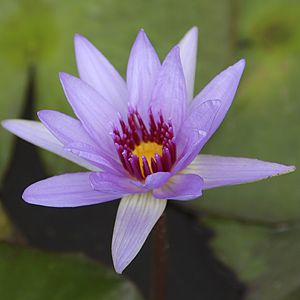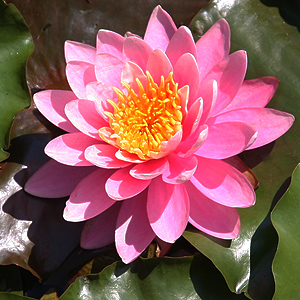
Water Lilies (Nymphaea) are the most popular aquatic plant for ornamental ponds. They require a little care when planting but are hardy and beautiful once they are established.
The leaves float on the surface of the water and the spectacular flowers add an exotic character to any water garden. Some water lilies have flowers that open and night, while others open in daylight hours.
Hardy water lilies are a must for any backyard pond. Waterlilies can also be grown in containers on the patio.
Hardy waterlilies will grow in USDA zones 3-9. Most varieties enjoy at least 6 hours of sunshine each day, but there are also those that will grow well in part shade. Miniature varieties are very delicate in appearance and are great for containers. Many types of hardy waterlilies have a wonderful fragrance. They bloom from spring to fall, and then the plants are dormant during winter.

Tropical waterlilies are suited to USDA 10-11 as they require water temperatures of 70 degrees or more. They are lifted from the pond and stored over winter.
The tropical lilies will provide your pond with large, showy, fragrant flowers. They produce more flowers than the Hardy varieties.
Planting Waterlilies
Water lilies are best planted in pots and then submersed into a pond. The depth at which they are submersed will depend on the type of water lily. The smaller growing varieties (miniatures) will be in shallow water perhaps only 20cm deep. Larger growing types will be planted in water up to 1m deep.
Choose pots that are wide and shallow. If your container has a drainage hole, line the container so soil does not escape and cloud the pond water. Hardy rhizomes can be divided with a sharp knife. Clean up leaves and old roots leaving a few emerging leaves and fine roots. Plant in a container of heavy garden soil with aquatic fertilizer mixed into it. Do not use light materials such as potting mix or perlite as these will float away. Plant 2 or 3 tubers around the sides of the pot, pointing at a slight angle towards the center. Finish with a layer of heavy sand or pea gravel on top as this keeps the plant and soil in place. Carefully submerge the pot to around 18 inches.
Care
When planting in larger ponds few problems arise, however in smaller ponds and containers the water can become stagnant and foul smelling. Overcome this by replacing the water regularly. Planting in submerged pots makes it easier to divide and fertilize your plants.
With over 50 species of both hardy and tropical water lilies and 1000s of cultivars, the variety in flower color, form and size is incredible.

